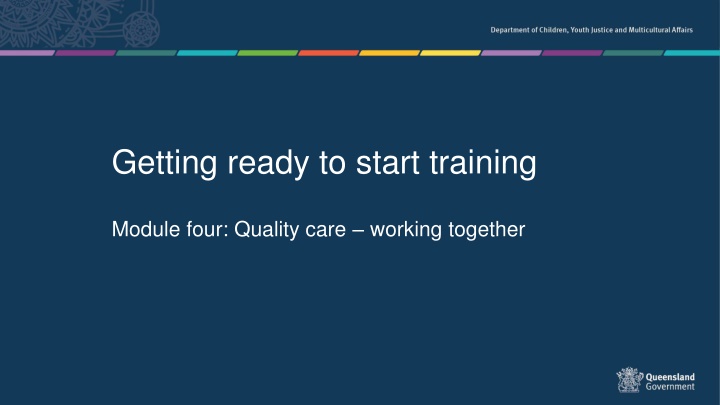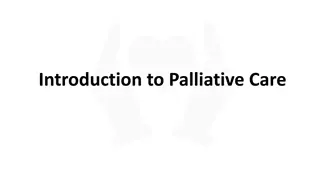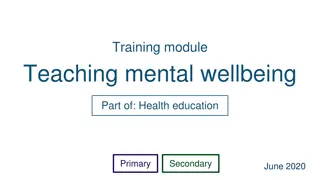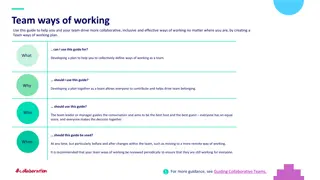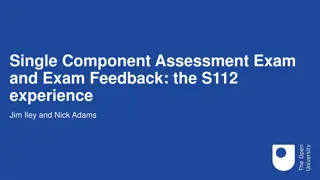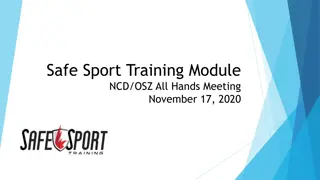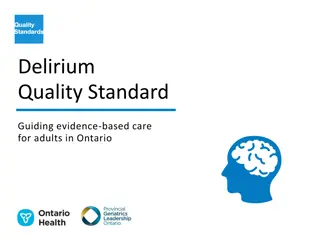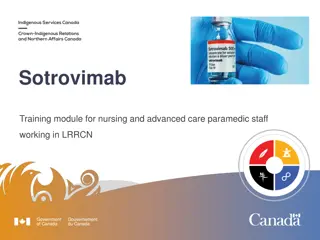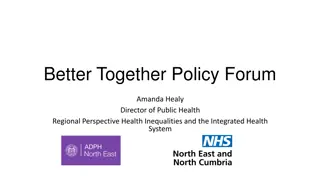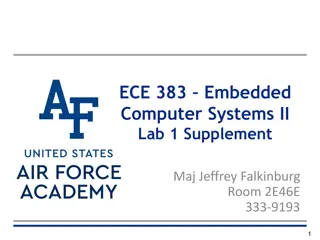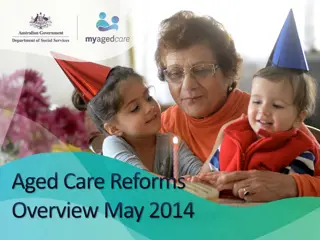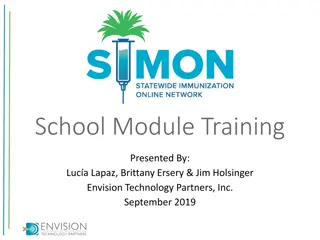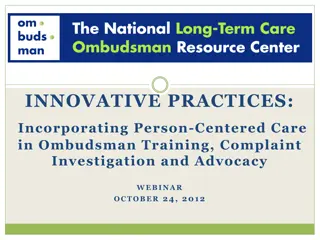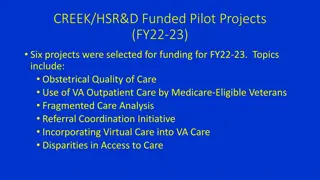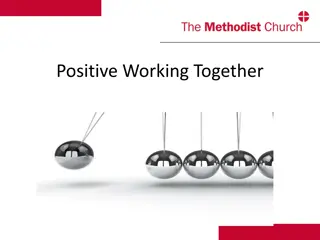Quality Care & Working Together: Module 4 Training Overview
This module focuses on the importance of partnerships in providing quality care for children and young people in care arrangements. It covers topics such as working in partnership, standards of care, carer supports, transition to independence, and the complexities of care arrangements. Participants will learn how key players can collaborate effectively, understand carer support options, transition to independence, and manage the end of care arrangements. The course emphasizes building strong relationships to achieve the best outcomes for children and young people, even during disagreements. The Statement of Commitment highlights the dedication to child safety and well-being by partner agencies.
Download Presentation

Please find below an Image/Link to download the presentation.
The content on the website is provided AS IS for your information and personal use only. It may not be sold, licensed, or shared on other websites without obtaining consent from the author.If you encounter any issues during the download, it is possible that the publisher has removed the file from their server.
You are allowed to download the files provided on this website for personal or commercial use, subject to the condition that they are used lawfully. All files are the property of their respective owners.
The content on the website is provided AS IS for your information and personal use only. It may not be sold, licensed, or shared on other websites without obtaining consent from the author.
E N D
Presentation Transcript
Getting ready to start training Module four: Quality care working together
Getting ready to start - Training modules Each participant will be assessed throughout the four modules on the following learning objectives: Module one context of foster care - completed An understanding of the process of how children and young people come into care and the impact of this process, and why children and young people require a care arrangement. Module two understanding the past for a child or young person - completed An understanding of trauma and related behaviours for a child or young person who is in care arrangement. Module three early days in a care arrangement completed Developing knowledge and skills required to meet the physical, emotional and social needs of children and young people in care and an understanding of the importance of participation by children and young people and their families in decision making. Module four Quality care & working together Have an understanding of the importance of partnerships between children, their families, foster and kinship carers and workers, (both in the government and non-government sectors), and their roles and responsibilities when working together as a team.
Module four: Quality care- Working Together Learning outcomes- module 4 At the end of this module you will be able to: Demonstrate how all key players can work together - including what to do when things go wrong Demonstrate an understanding of carer support options Demonstrate an understanding of transition to independence Demonstrate an understanding of the complexities of when a care arrangement comes to an end
Module four: Quality care- Working Together 1. Working in partnership Statement of Commitment 2. Standards of Care (SOC) What is a Standard of Care What is a Harm Report 3. Carer supports General Support Financial Support Changes in Carer Circumstances 4. Guest panel 5. Transition to Adulthood (T2A) What is T2A? How can you support T2A as a carer? Resources 6. Saying goodbye When a child or young person moves on 7. Conclusion and Evaluation
Working in Partnership Statement of Commitment Child Safety and the Qld peak child protection agencies (partner agencies) through the Statement of Commitment have made a commitment to work together with you to: Make a difference in the lives of children and young people Ensure the safety, belonging and wellbeing needs of the children and young people in your care are met Ensure Aboriginal and Torres Strait Islander children and young people in care maintain their cultural identity and relationship with their family and community Do our best for you so you can do your best for the children and young people in your care Build a good relationship that will help us work together to get the best outcomes for children and young people, even when we disagree or see things differently Uphold the human rights of children and young people in your care. The Statement of Commitment can be found at the link below or via the QR code to the right. Statement of Commitment - foster and kinship carers of Queensland (www.qld.gov.au) Statement of Commitment QR code
Working in partnership Who might you be working in partnership with to enhance the child s care arrangement?
Working in Partnership Statement of Commitment cont. Each party of the Statement of Commitment have roles to play, these parties include: Child Safety Foster and kinship care services Foster and kinship carers Peak bodies and advocacy groups QFKC Queensland Foster and Kinship Care PeakCare Queensland QATSICPP - Queensland Aboriginal and Torres Strait Islander Child Protection Peak CREATE
Working in Partnership Carer roles Statement of Commitment cont. Provide a caring environment for children and young people Provide care consistent with the Statement of Standards and Charter of Rights Ensure Aboriginal and Torres Strait Islander children and young people are connected to family, community and culture Participate in the decisions affecting the lives of the children or young people in their care Provide feedback to influence the development of and change to the policies that affect foster and kinship care practices Participate in, and support the planning and deliver of training
Working in Partnership Child Safety s roles Statement of Commitment cont. ensuring the care provided to children in care is consistent with Statement of Standards, Charter of Rights and the Aboriginal and Torres Strait Islander Child Placement Principle consulting with children and young people and supporting them to participate in all decisions. actively support and facilitate the participation of Aboriginal and Torres Strait Islander families and communities in all decision making processes working with parents to address concerns so children and young people s permanent care is, wherever possible, provided by their parents. ensuring that where reunification is not possible, concurrent planning allows for a child or young person s safety, belonging and wellbeing to be met working with non-government, community-based foster and kinship care services ensuring care arrangement needs and supports for children are clearly documented
Standards of Care What is a Standard of Care (SOC)? The Statement of standards (Child Protection Act 1999, section 122) sets out the standards by which children in care are to be cared for. These apply to all care arrangements made under the authority of the Child Protection Act 1999, section 82(1). Where concerns are identified Not all concerns are the same, depending on the nature of the concern and the possible impact on the child or young person, determines how Child Safety responds. Possible responses will include: Continuing to monitor care Conducting a standard of care review Investigating and assessing harm
Standards of Care Continue to monitor Continue to monitor care This response may occur when Child Safety decides there are some worries or issues about the quality of care the child or young person is receiving. Generally most concerns can be addressed through the regular formal supports provided by your agency support staff or the child/young person s CSO. Child Safety and/or your support agency will discuss these issues with you to work out what additional supports are needed that could help.
Standards of Care Standard of Care Review A Standard of Care Review (SOCR) occurs where there are concerns that a child or young person has been provided with care that has not met the standards of care as outlined in the Child Protection Act 1999, section 122. Where Child Safety have determined that the legislative standards may not have been met, Child Safety will: Work in partnership with your foster and kinship care agency to speak to you about the concerns Talk to you and obtain your views about the stated concerns Explore your experience of supporting the child or young person Ask you about the supports being provided to you and the child or young person, or if more supports are required Find out if there are any additional stressors in the household Speak to the child or young person about their care environment Take into account the roles and responsibilities of the safety and support network Reach an outcome, either standards met or standards not met. Advise of the outcome of the SOCR Where standards have not been met a review of the placement agreement will be arranged
Harm Report Investigating and assessing harm In consultation with your support agency, Child Safety will record a harm report where there is information to suggest that a child or young person in your care may have been harmed. This is a more serious process and requires an investigation and assessment by Child Safety, and depending on the allegations sometimes Qld Police may also be involved. As part of the process of a harm report Child Safety will: Work with the support agency to discuss the concerns and plan a response to the allegations Provide you with written information about the allegations Interview you, the child and other relevant people Assess whether the standards of care are being met (similar to the SOCR) Reach an outcome about whether or not the child or young person has experienced harm If Child Safety determine there is a high risk to the child or young person, they may decide to remove the child or young person from the care arrangement.
Harm Report Harm report outcomes: Substantiated harm standards not met Substantiated harm standards met Unsubstantiated standards not met Unsubstantiated standard met No outcome (in exceptional circumstances only) An action plan will be developed with Child Safety, you and the safety support network if the child or young person s care has been assessed as not meeting the standards.
Carer Supports Organisation Phone Email / links Queensland Foster and Kinship Care (QFKC) 07 3256 6166 admin@qfkc.com.au FAST representatives 07 3256 6166 Download the latest list of FAST Reps here Foster and kinship carer support line 1300 729 309 Send a referral Child Safety After Hours Service Centre (carers only) 07 3235 9901 Queensland Aboriginal and Torres Strait Islander Child Protection Peak (QATSICPP) 07 3102 4119 Contact QATSICPP 1800 655 105 or 07 3317 6020 (Brisbane office) CREATE Foundation create@create.org.au 13 Health (13 432 584) Queensland Health Contact us | Queensland Health Office of the Public Guardian (OPG) 1300 653 187 publicguardian@publicguardian.qld.gov.au Child Safety staff contact details will be applicable to your CSO and the CSSC affiliated with you Foster and Kinship Care agency contact details should be provided by your FKC support agency
Carer Supports FAST representatives FAST Foster Advocacy and Support Team FAST is a primary service delivery area for QFKC FAST - is funded by the Department of Children, Youth Justice and Multicultural Affairs FAST representatives are active carers with at least two years caring experience who have been professionally trained and supervised through QFKC to provide support, advocacy and advice to other carers There is a FAST representative based regionally and who have knowledge and partnerships which benefit their support of other carers For those areas where there is no FAST representative simply call QFKC s office directly, case officers are ready to take your call 3256 6166
Carer Supports Professional development Learning carer information fact sheets, journal articles, internet Training Standard training Advanced training Targeted training for different skill levels or learning needs Reflection on role/skills Foster & Kinship Care agency training Financial Support Fortnightly caring allowance Regional and remote loading Child Related Costs (CSSC) High Support Needs Allowance (HSNA) Complex Support Needs Allowance (CSNA) Centrelink (Family Tax Benefit) Emotional Support Carer support line FKC support worker FAST representative Short-Break (Respite) Friends/family & support networks CSO Child Safety After HoursService Centre Task focused problem solving support Specialist advice and assistance Psychiatric Medical services Education services Facilitating referrals for children to specialist service Social Supports Access to support groups and networks Friends and family Access to groups QFKC, FAST representatives Foster and kinship care groups Practical Support FAST representative CSO FKC worker Carer information sheets Carers business discount card Information for Carers website page Information for carers QR code
Carer Supports Change in carer circumstances As part of the team you need to tell Child Safety if you, or any of your household members have any changes in circumstances. These changes could include: Household membership a new person wants to join your household (this person must hold a current blue card before they can apply to be a household member) or A current household member leaves Spousal arrangements new partner (to be living in the home), divorce, separation, death Any changes in personal history i.e. traffic history, criminal or domestic and family violence history Involvement by any child protection agency in Australia Personal circumstances health issues, employment demands Change of address new Household Safety Study will need to be completed Intention to provide care to other children relatives, family day care Complete a Change in Carer Circumstances form and provide it to your CSSC. A review of your foster carer agreement may need to occur depending on the changes. Change in carer circumstances form QR code
Guest Panel and/or CREATE PowerPoint
Transition to Adulthood All young people subject to a CPO granting custody or guardianship to the Chief Executive have the right to receive assistance and support with their transition to adulthood (T2A), to maximise their life opportunities and choices. T2A planning is integrated into case planning for a young person from the age of 15 years. There isn t a one- size-fits-all approach to transition planning, and planning should move beyond what the young person needs for their survival and incorporate resilience and life skills. It should be ambitious. We need to encourage young people to be active in their participation to ensure their transition planning is successful for them. We need to be respectful and proactive in engaging young people at their pace in transition planning.
Transition to Adulthood Young people in care need to have connections to their families, because this provides ongoing relationships and support as they move into adulthood. Relationships with parents, siblings and extended family need to be revisited regularly to find opportunities to strengthen them or reconnect. It is essential that we establish a robust safety and support network and form partnerships with those in the young person s network. In the planning process, we use other relationships that the young person may have with professionals or friends. These people can establish effective relationships and assist with communication. Collaboration delivers better outcomes.
Transition to Adulthood Child Safety will work with the young person to meet their identified T2A goals, which may include: Getting financial assistance for further studies, apprenticeship/traineeship etc. Obtaining a driver s license Developing life skills e.g. cooking or budgeting Moving into semi-supported accommodation Assisting in applying for TILA (Transition to Independent Living ) payments of up to $1,500
Transition to Adulthood What carers can do? Continue to support the young person in your home: a young person who has been in your care at age 17 can remain in your household once they have turned 18 with Child Safety continuing to pay the fortnightly caring allowance until they leave your household prior to or upon their 19th birthday. A young person turning 18 who will continue to reside with you past their 18th birthday - and where you will continue to be an approved foster carer will need to apply for a blue card and complete a New Adult Household Member form. Support for young people who will be leaving your care prior to, or upon their 18th birthday: Referrals assist the young person to access services that can help them in the short term and long term Assist with T2A planning with assistance from their CSO, help the young person plan their transition to adulthood Individual advocacy advocate on behalf of the young person to ensure they receive the supports they need. Support provide emotional and practical support the young person will need for their journey into adulthood and beyond
Transition to Adulthood Resources There are a range of resources to assist the young person and their care team plan for transition to adulthood: Sortli app managed by the CREATE foundation, is a free mobile app to help young people plan their future, it has been developed by young people and professionals who work with young people. *not suitable for young people under 15. Android QR code CREATE Resources Apple QR code CREATE foundation Transitioning from care video resources CREATE your future Go your own way Info Kit - developed by CREATE resource for young people 15 years and over who are transitioning to adulthood
Transition to Adulthood Qld Health resources Resources cont. Understanding PTSD for young people in Care Department of Social Services Transition to Independent Living Allowance (TILA) website Understanding Depression for young people in Care Next Step Plus will assist young people in care from the age of 15 to develop the skills and knowledge they needs to successfully transition from care to adulthood, and ensure those who have left care are able to receive tailored support, should they need it. Support from Next Care Plus can be provided to young people up to 25 years of age. Understanding Anxiety for young people in Care More information on Next Step Plus can be found at the website below or click on the QR code to the right. www.nextstepplus.com.au
Saying Goodbye When a care arrangement ends The child or young person you care for is part of your extended family, but sooner or later that child or young person may leave to either move back home , live on their own or live in another care arrangement. Planned move from a care arrangement Planned moves are best for children and young people and also for your family. Planned moves will involve meetings with you, the child or young person in your care, Child Safety, the care agency support worker and other members of your family if appropriate. Unplanned move from a care arrangement Sometimes a breakdown between you and/or your family and the child or young person can occur and moving to a new care arrangement may be the only solution. Important not to part in anger and when saying goodbye be positive. Information for carers When a care arrangement ends
Saying Goodbye Conclusion of Care arrangement At the end of a care arrangement, it is important that your valuable information about a child or young person is made available to the person who next cares for them. This should be recorded in a Conclusion of placement form, which your CSO should give you. It covers a range of information that the carer has first-hand knowledge about: Significant friendships or significant others in the child or young person s life Their relationship with the carers family and their reaction to the care arrangement ending Hobbies, interests or social activities or sports including swimming ability Medical and dental information Scheduled appointments The personal records that were returned (and to whom) The key belongings that are going with the child (e.g., computer, bicycle etc.)
Module four: Quality care- Working Together Learning outcomes- module 4 Demonstrate how all key players can work together - including what to do when things go wrong Demonstrate an understanding of carer support options Demonstrate an understanding of transition to independence Demonstrate an understanding of the complexities of when a care arrangement comes to an end
Reflection Did anything change from when your first started to now? Do you have any concerns as a result of the information you know now?
Where to from here for you? A formal assessment report to be prepared and discussed with you. Upon completion of your assessment the assessor will make a recommendation to Child Safety to approve or refuse the application If approved, further training modules are to be completed in your 1st year of caring (3 modules) Learning journal to reflect on learnings As an approved carer and after your initial 1st year approval, you will be required to renew your carer approval every 2 years.
